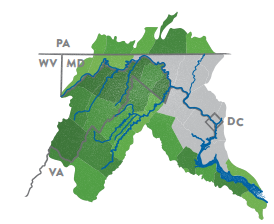According to the Potomac Conservancy's 2014 State of the Nation's River, it is estimated that by 2040 the population in areas surrounding the Potomac Watershed will increase by 2.3 million residents. If this explosive population growth is not planned correctly it could be catastrophic for the health of land, waterways, and drinking water sources.
 The added development, fueled by population growth, could lead to harmful land use practices such as sprawl. Sprawl is defined as the decentralization of human occupancy, or increased development of land in suburban and rural areas. Increased development in these areas often means the lack of development, redevelopment, or reuse of land within urban centers, which requires more land, space, and resources to supply the same population. This leads to deforestation, loss of natural stream buffers, and weakened natural flood barriers, and greater pollution levels in streams and rivers.
The added development, fueled by population growth, could lead to harmful land use practices such as sprawl. Sprawl is defined as the decentralization of human occupancy, or increased development of land in suburban and rural areas. Increased development in these areas often means the lack of development, redevelopment, or reuse of land within urban centers, which requires more land, space, and resources to supply the same population. This leads to deforestation, loss of natural stream buffers, and weakened natural flood barriers, and greater pollution levels in streams and rivers. In their State of the Nation's River report, the Potomac Conservancy gives rural areas, lands in the west where the Potomac Watershed begins, an overall stream health rating of Good. Unfortunately, the future of these streams is threatened by encroaching sprawl. New development in this region is threatening forests that capture and filter water, stabilize stream banks, and control flooding. These forests are being lost at 100 acre per day. Luckily some action is already taking place, for example the Open Space Institute is providing $5.5 million to fund local land protection initiatives along the South Branch of the Potomac, and Marylands "Sustainable Growth and Agriculture Preservation Act of 2012" is attempting to slow the loss of forest and agriculture land the careful development planning.
In their State of the Nation's River report, the Potomac Conservancy gives rural areas, lands in the west where the Potomac Watershed begins, an overall stream health rating of Good. Unfortunately, the future of these streams is threatened by encroaching sprawl. New development in this region is threatening forests that capture and filter water, stabilize stream banks, and control flooding. These forests are being lost at 100 acre per day. Luckily some action is already taking place, for example the Open Space Institute is providing $5.5 million to fund local land protection initiatives along the South Branch of the Potomac, and Marylands "Sustainable Growth and Agriculture Preservation Act of 2012" is attempting to slow the loss of forest and agriculture land the careful development planning.Suburban areas are rapidly increasing with population growth moving out of the D.C. metro area. With a overall stream health of Moderate, these areas are quickly increasing impervious surface cover and losing forest and croplands, reducing the lands ability to absorb rainwater and filter runoff. To avoid degrading the stream quality more, these areas needs to plan clustered growth centers and create areas of conservation to prevent sprawl and protect natural stream buffers. Currently, Loudoun, VA, and Frederick, MD are experiencing explosive population growth and are are not developing responsibly. Potomac Conservancy cited a few threats to clean water in these areas, such as the Trump National Golf Course that clear-cut 1.5 miles of shoreline or 400+ trees, and ignoring state anti-sprawl laws and building subdivisions in forested and farmland areas that should be protected under the 2012 Sustainable Growth and Agricultural Preservation Act.
Urban areas received an overall stream health rating of Poor. The most notable threat to the Potomac in this region is aging sewer and water infrastructure. On average busted pipes and overflows lead to 600 million gallons of sewage being leaked into the Potomac, and 1.5 billion gallons into the Anacostia, each year. This endangers and wildlife and people that come in contact with the river water by exposing them to dangerous pathogens and bacteria. In order to protect these areas from the dangers of increased population size, and strain, nature based solutions to capture and filter polluted runoff need to be put in place. In addition, the stormwater and sewage infrastructure needs to be upgraded, and the redevelopment of existing city centers needs to be invested in (build up not out). So far the DC Water and Sewer Authority and the EPA have partnered on the Clean Rivers Project to reduce all sewer runoffs by improving wastewater and stormwater infrastructure and to invest in low-impact development and green infrastructure strategies.
In summary, the Potomac Conservancy asserts that with through thoughtful development population growth within the Potomac Watershed can lead to sustainable, vibrant communities that maintain the integrity of the water systems.
Potomac Conservancy: 2014 State of the Nation's River




No comments:
Post a Comment